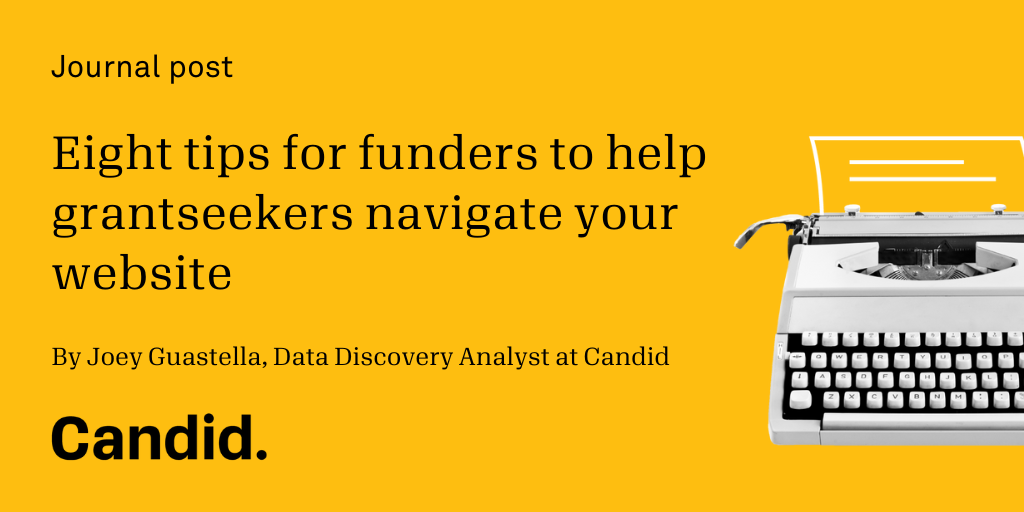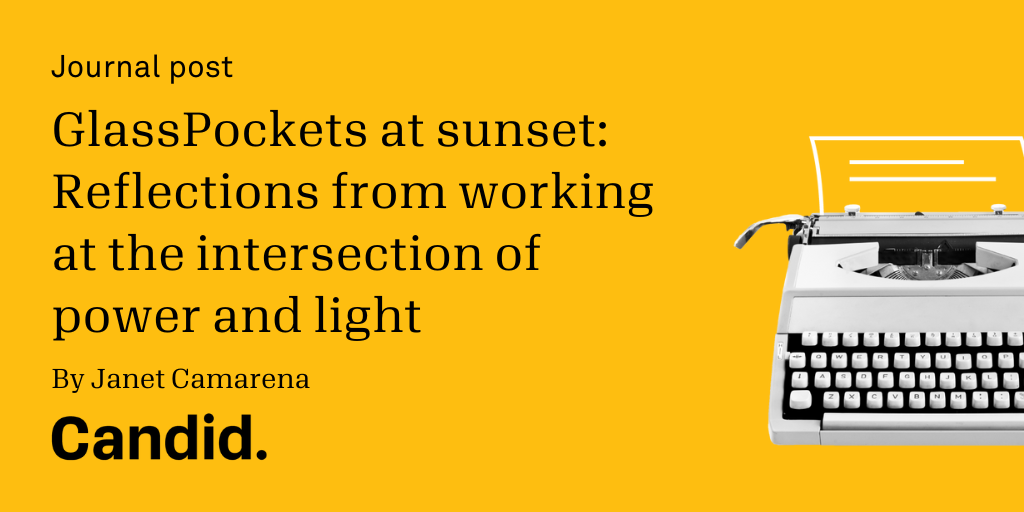New Guide: Demystifying and DeMYTHifying Foundation Transparency
(Janet Camarena is the director of the Foundation Center's San Francisco office and leads the Center's Glasspockets effort.)
As the mother of a nine-year-old boy, I have spent many hours in front of the MythBusters television show and witnessed first-hand the power that broadcast experimentation mixed with testing long-held truths has to make science fun. Is food that has been on the floor for five seconds really safe to eat? MythBusters has an episode to test that theory. Today, as a result of a team effort between GrantCraft and Glasspockets, we are launching a new GrantCraft guide authored by Susan Parker, Opening Up: Demystifying Foundation Transparency, and I am reminded of the MythBusters approach because much of the guide’s wisdom refutes long-held beliefs about foundation transparency.
Download the guide»In terms of experimentation, the guide’s research involved a survey of more than 700 philanthropy professionals and in-depth interviews with 25 grantmakers. From this knowledge base, a helpful roadmap emerged to help grantmakers through the hows and whys of transparency. And, indeed, one of the things I think many grantmakers will find most helpful is the step-by-step infographic that illustrates the various paths one can take to transparency, along with the following definition of foundation transparency:
"Transparency is, in a word, openness. A foundation that operates transparently is one that shares what it does, how it does it, and the difference that it makes in a frank, easily accessible, and timely way."
Another helpful aspect of the guide is in keeping with the traditional GrantCraft model of sharing practical wisdom from grantmakers with many helpful case studies and examples. As I read through the practical wisdom that these voices have shared, I see a pattern emerging that debunks certain myths or preconceived notions some grantmakers have shared with our Glasspockets team over the years, ideas that often stand in the way of greater foundation transparency. The myths below are a collection of what I have heard the last four years of working on Glasspockets, and the reality comes from selected examples featured in the guide. I hope this framework, like MythBusters, serves to make foundation transparency a bit more fun!
Myth #1: Transparency takes too much time away from the real work of the foundation.
Reality: While transparency is part of a process that does require staff time and attention, echoed throughout the many case studies in the guide is the simple fact that one of the many benefits of transparency is that it actually creates efficiencies that are net time savers over the long haul.
For example, in the first section, on sharing grantee selection processes and grantee data, a case study featuring the Open Estonia Foundation reveals that prior to posting detailed application guidelines on its web site, fully half of the applications it received were inappropriate. But since posting the guidelines in 2009, only about 10 percent of the applications it now receives are ineligible.
Later on in the guide, a grantmaker reflects on how his institution has managed to make time for its program officers to participate in social media. Stephen Downs, chief technology and information officer at the Robert Wood Johnson Foundation, reminds his team members that if keeping on top of trends and interesting thinkers in their field is important, then there is no better or more efficient way to do that than to use social media.
So, the bottom line is not that transparency takes too much time, but rather that transparency is simply part of doing an effective and efficient job as a grantmaker.
Myth #2: Internal reports should stay internal forever.
Reality: Foundations spend a lot of time and money producing knowledge that helps inform strategic directions, staff and board decisions, and guides the work of the foundation. Sadly, due mainly to a non-technological legacy, these valuable documents never see the light of day outside the foundation. However, as a result of the increasing awareness of the potential value of this data to others, along with the rapid pace of technology that can facilitate its sharing, several examples in the guide point to foundations that are going beyond their usual comfort zone and making internal reports available to the public. In so doing, they’ve reported many benefits, including improved relationships with both peers and grantees. The second section, on sharing performance assessments, provides several examples of internal reports and documents finding a second (and in some cases a more valuable) life outside the foundation.
One compelling example is from the Oak Foundation in Geneva, Switzerland, which had commissioned an internal report to review its work in the area of international human rights. Recognizing that there was much in the report that would help its peers , the foundation invited other international human rights funders to a meeting to discuss how the findings could be valuable to field as a whole. Listen to the podcast of our interview with the Oak Foundation to learn more.
Myth #3: Since my foundation annually submits the IRS Form 990-PF, which is available to the public, I can check transparency off of our foundation’s "to-do" list.
Reality: As the guide outlines, key parts of foundation transparency are timeliness and accessibility. Given that there can be a delay of two years or more in accessing a particular foundation’s 990-PF, this regulatory document is not the best method to foster transparency. The third section of the guide is devoted to highlighting how transparency serves as a means to improving relationships with grantees and other stakeholders. In this chapter James Canales, CEO of the James Irvine Foundation, explains that the foundation goes beyond the 990-PF when it comes to sharing its executive compensation practices, because asking someone to sift through a 350-page report to find what they are looking for is not very transparent. Further, the guide cites examples in other parts of the world where there is no 990-PF, where funders are voluntarily posting financial data online.
Myth #4: Foundation transparency mainly benefits those outside the foundation world.
Reality: As I reviewed the guide’s many funder examples, an irony emerges: Many times grantmakers will set out to increase their transparency practices, but see it as something that will benefit only grantees and other outside stakeholders. Yet, once the new web site is up and running, or the searchable grants database is available, or the map visualizing their grants is posted, they become aware of the value increased transparency has for themselves. The fourth section of the guide offers several examples of how transparency improves the practice of philanthropy and serves to actually make life easier for those who must make informed philanthropic decisions as part of their day-to-day work.
Myth #5: Our foundation will lose respect if we publicly discuss mistakes or flawed strategies.
Reality: Foundations, many of which are accustomed to operating in an "under-the-radar" way, often fear the risks they perceive as being associated with increased transparency, so they avoid the institutional vulnerability that may come with increased attention. The fifth section, on recognizing opportunities for connecting, includes a case study from the California Endowment’s efforts to own up to mistakes on its blog. It is a refreshing example in a field that is much more comfortable either touting its successes or remaining silent. Listen to the podcast of our interview with the foundation to learn more.
Throughout the guide, a recurring and reassuring theme emerges among the case studies: Despite initial misgivings around the risks of sharing mistakes and fears of being ridiculed on social media, foundations happily discover that being open results in others respecting their candor and holding them up as positive examples for the field.
We hope this guide sparks discussion and learning, and encourages more positive examples of transparency. The PDF guide is complemented by online components, including podcasts of interviews and the complete results of the transparency survey. As always, we’ll continue the conversation with examples of foundation transparency here on our Transparency Talk blog. If you have an example you would like us to feature, please share in the comments below.
-- Janet Camarena




